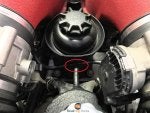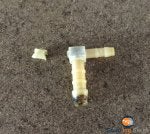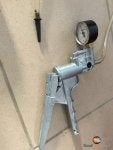P2187 - Long term fuel trim bank 1 (or OBD system too lean at idle)
P2189 - Long term fuel trim bank 2 (or OBD system too lean at idle)
I was getting both DTC error codes simultaneously without any other errors or signs. After clearing the codes and running the car on the Texa to monitor the different Lambda, short and long term values, etc, these DTC errors came quickly back. The long term fuel trim % started to raise quickly on both banks when revving the engine at higher rpm. The engine slightly lost power and wasn't responsive as usual. Idle was a little rough too but never stalled.
Checked the vacuum tank and hoses and found that it took an unusual long time to get a decent vacuum level. This made me suspect a vacuum leak from the intake and started checking the anti-EVAP pipes with a vacuum/pressure pump (very useful). No leaks found on the anti-EVAP system, including the one-way valves and the pump was operating perfectly well.
Checked the hose going from the air/oil separator towards the LHS/RHS intake manifold and found that it was impossible to pressurize it. Removed all 3 hoses from the T joint and bingo, this small plastic T joint had a small hair crack inside one of the hoses. This T joint costs only a couple of cents but can lead to big repair bills as it may take quite some time to locate the root cause of the generic P2187/P2189 errors. Replaced it with a better plastic T joint and error codes were gone. Engine became very responsive again with stable idle. Problem solved.
As our cars are getting older, it may be a good idea to anticipate such issues by preventively replace this T joint.
P2189 - Long term fuel trim bank 2 (or OBD system too lean at idle)
I was getting both DTC error codes simultaneously without any other errors or signs. After clearing the codes and running the car on the Texa to monitor the different Lambda, short and long term values, etc, these DTC errors came quickly back. The long term fuel trim % started to raise quickly on both banks when revving the engine at higher rpm. The engine slightly lost power and wasn't responsive as usual. Idle was a little rough too but never stalled.
Checked the vacuum tank and hoses and found that it took an unusual long time to get a decent vacuum level. This made me suspect a vacuum leak from the intake and started checking the anti-EVAP pipes with a vacuum/pressure pump (very useful). No leaks found on the anti-EVAP system, including the one-way valves and the pump was operating perfectly well.
Checked the hose going from the air/oil separator towards the LHS/RHS intake manifold and found that it was impossible to pressurize it. Removed all 3 hoses from the T joint and bingo, this small plastic T joint had a small hair crack inside one of the hoses. This T joint costs only a couple of cents but can lead to big repair bills as it may take quite some time to locate the root cause of the generic P2187/P2189 errors. Replaced it with a better plastic T joint and error codes were gone. Engine became very responsive again with stable idle. Problem solved.
As our cars are getting older, it may be a good idea to anticipate such issues by preventively replace this T joint.








